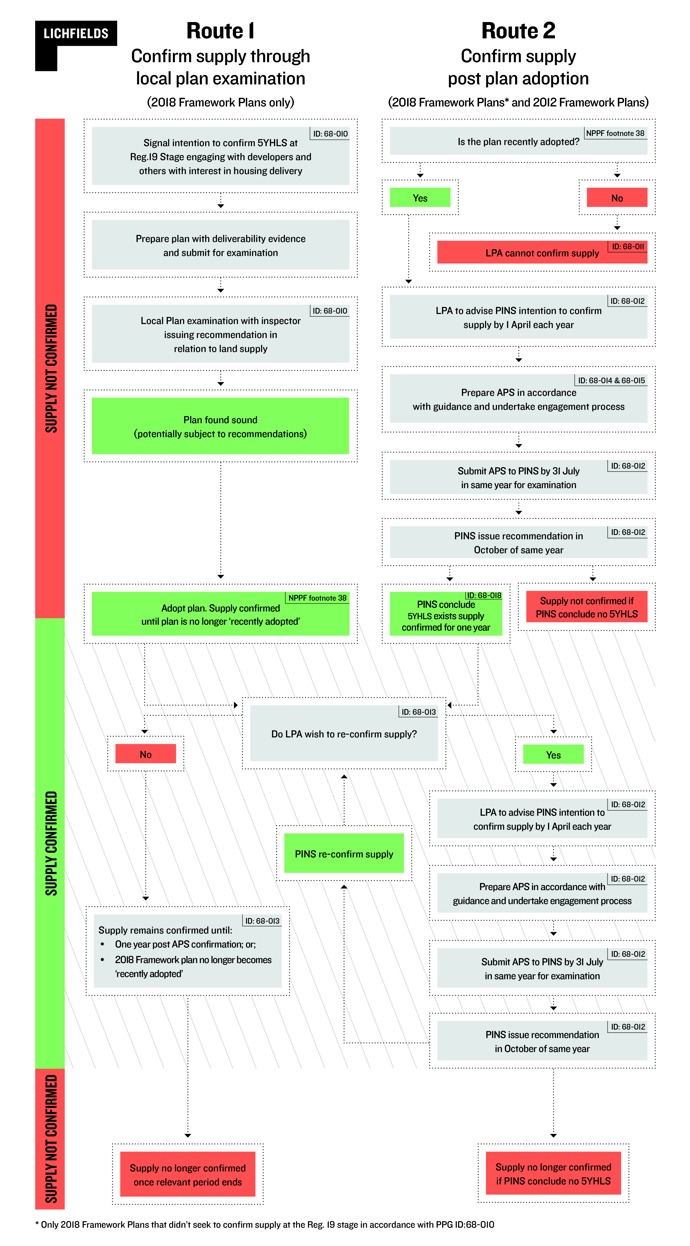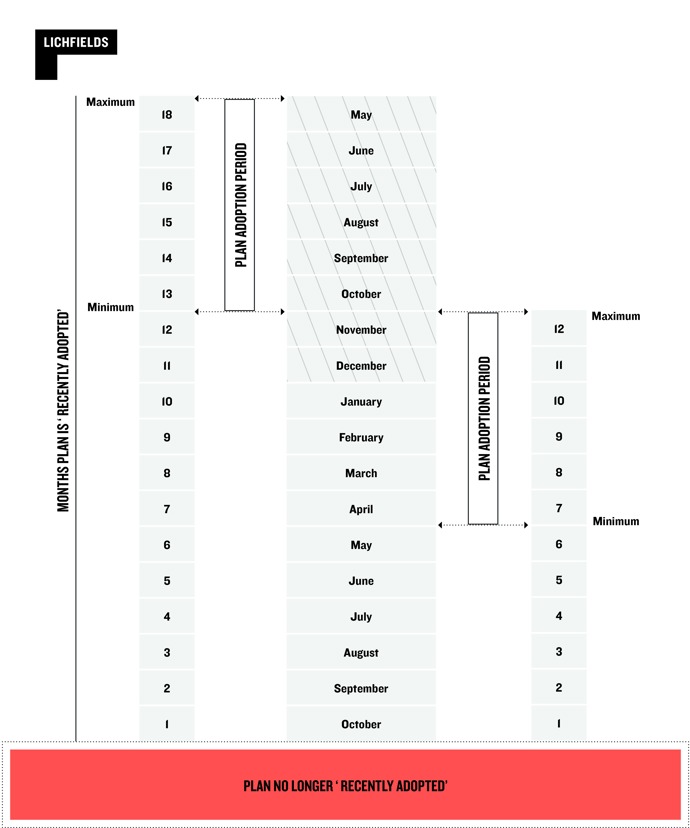In this second blog reviewing the new Planning Practice Guidance (‘PPG’) section on ‘Housing Supply and Delivery’, I take a look at the changes related to ‘confirming’ a Five-Year Housing Land Supply (‘5YHLS’) through a ‘Recently Adopted Plan’ or ‘Annual Position Statement’ (‘APS’).
Local Planning Authorities (‘LPA’) have had the ability to ‘confirm’ (i.e. fix) its 5YHLS position since the publication of the revised NPPF (July 2018). At the time of writing, no LPA has yet confirmed its supply, nor realistically could any have done so based on the wording of the Framework. However, there are obvious incentives to LPAs in having a ‘confirmed’ 5YHLS so it is important to understand the process.
We have prepared a simple(ish) flowchart for reference, showing how an LPA in various circumstances can confirm its supply based on the new guidance.

Furthermore, whether a plan is ‘recently adopted’ (as per footnote 38 of the NPPF) is key to understanding whether an LPA can confirm its supply. The below diagram visualises when a plan is and is not ‘recently adopted’.

As can be seen, it is advantageous for an LPA to adopt a plan between 1st May to the 31st October (in the same year) as that plan will be ‘recently adopted’ for between 12 and 18 months. If a plan is adopted between 1st November in one year to the 30th April in the next, that plan will at most be ‘recently adopted’ for 12 months, but potentially as short a period as 6 months.
LPAs should now seriously consider the date of adoption in this context.
Other key matters set out in the new PPG:
1) Confirmation that LPAs with a ‘recently adopted’ Local Plan assessed against the previous 2012 NPPF can confirm its 5YHLS through a subsequent APS
The PPG (ID: 68-011) helps clarify the recent uncertainty over which local authorities are eligible to pursue an APS that fixes the 5YHLS for a year.
Whether a plan is ‘recently adopted’ is determined by Footnote 38 of the NPPF (see diagram 1 above): therefore, in the current circumstances any LPA that has adopted a 2012 assessed local plan since 1st May 2018 to 30th April 2019 could technically have prepared an APS and submitted this to the Planning Inspectorate (‘PINS’) for examination this year. PINS are meant to publish a list on their website a list of LPAs that are seeking to confirmation their 5YHLS. This list does not appear to have been published at the time of writing, but there are 34 LPAs who could technically have notified PINS of its intention to confirm its supply.
Of course, the confirmation that these LPAs could submit an APS has only just been published, so it is unlikely many would have tried to prepare one: that said, both Fylde and Wyre Councils have undertaken consultations on their APSs. Many will therefore have lost the ability to confirm a supply in future years (see point 3 below).
Going forward, any LPA that adopts a 2012 NPPF-assessed local plan on or after 1st May 2019 has the ability to notify PINS by 1st April 2020 of its intention to prepare an APS.
2) It also appears that a ‘recently adopted’ Local Plan assessed against the 2012 NPPF does not, in and of itself, ‘confirm’ a 5YHLS
The wording of the old guidance did suggest this might be the case, but a number of appeals decisions determined the contrary[1]. The new guidance of PPG ID: 68-011 appears to only permit 2012 framework plans to benefit from the ability to produce an APS to confirm a 5YHLS post-adoption, rather than relying upon the adoption of the plan itself. This makes sense given 2012 NPPF plans were tested against the old definition of ‘deliverable’.
3) If an LPA fails to confirm its supply, it cannot re-confirm its supply again until it adopts a new local plan
The two options for confirming a supply is through either a ‘recently adopted’ 2019 NPPF-assessed plan or through a subsequent APS (PPG ID: 68-004). The new guidance states that to submit an APS that LPA must either have (ID: 68-013):
- A recently adopted plan (2019 or 2012 NPPF assessed); or
- A confirmed land supply following a previous APS.
On this reading, any LPA that is found not to have a 5YHLS through the APS process, or simply fails to submit an APS when its local plan (2012 or 2019 assessed) is ‘recently adopted’, loses the ability to confirm its supply in future years until it adopts a new local plan.
4) Ambiguity remains for plans adopted between 2nd April to 30th April
As per our diagram, a plan (2012 or 2019 Framework) adopted between these dates is only ‘recently adopted’ until October 31st in that same year. However, as per guidance that LPA will need to advice PINS of its intention to prepare an APS by the 1st April (PPG ID: 68-012) in that same year: i.e. prior to adopting that plan. That LPA could not wait until April in the next year as the plan would no longer be ‘recently adopted’ as of October in the current year. That LPA would therefore fail the first stage of APS assessment (PPG ID: 68-013).
Presumably, that LPA would need to notify PINS of its intention to adopt a plan before 30th April and prepare an APS before the 1st April in that year.
5) Big questions remains regarding the level of consultation required for an APS
Guidance on the consultation process for APSs remains vague but the key test is whether “satisfactory stakeholder engagement has been carried out” (PPG ID: 68-013 – taken across from the former PGG ID: 3-051).
The new guidance includes a slightly updated list of potential stakeholders, detailing who the authority can (not ‘should’ as per the previous guidance – PPG ID: 3-052) engage with. The guidance now also states that “Beyond this [list], it is for the local planning authority to decide which stakeholders to involve.” (PPG ID: 68-016).
It is too early to tell what degree of consultation is ‘satisfactory’, given no APS has yet been examined, but it would appear that the PPG overall (both new guidance and that consistent with the previous version of the PPG) allows for a more limited and potentially insular engagement process. This could lead to a lack of objective voices properly challenging the assumptions of developers/LPAs regarding, for example, delivery rates and lead-in times for sites in the trajectory. This is important because real risks exist of trajectories being affected by self-serving (unconscious) ‘optimism bias’ of local authorities and those developers with sites in in the 5YHLS. This risk needs to be mitigated and local plan examinations and s.77/78 inquires show the benefit of external challenge in helping PINS keep the process ‘honest’.
We will need to wait and see how the evidence submitted as part of an APS is assessed in practice.
[1] APP/M2325/W/17/3179277, APP/W0530/W/18/3209758, APP/D3125/W/18/3202562





